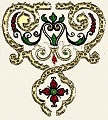|
|
 |
Female
Hairstyles
|
 |
In the early
1630s the hair was drawn back from the forehead with side partings
on both sides of the head and curls hanging from them, and sometimes
at the back of the neck. A small chignon was worn halfway
up the back of the head. In general shape the fashion continued
the same after mid-century, but from 1660 until 1670 there was
a custom of wiring out the curls dangling on either side of the
head. These were often thicker and more numerous than formerly.
During the same time there was a parallel fashion of wearing the
hair short, in a mop of downward-pointing ringlets all over the
head, arranged fairly thickly at the back, called an hurluberlu coiffure.
The earlier
soft, curly hairstyles were then gradually replaced by more rigid
ones. Already in the 1660s the long, lavishly displayed side locks
were reduced to a few thin, spiral locks, while the rest of the
hair, the remaining biggest part, was towered onto the top of
the head as well as widened to the sides. During the course of
the eighties the hairstyle took over the form which seemed to
tower into great heights, which was then adapted by the ladies
and carried on as fashionable for decades, Just like the gentlemen's
periwig. The hatters in the middle of the 1680s was the Fontange
à la Sultane, which was not towered yet, no wire construction
was used, but soon enough this was going to change, and what we
now know as the Fontange, and which seems to sum up the
Baroque hairstyle and hatters of women, was to be developed.
Sometimes towering so high on its base of fluffed up natural hair
and hair extensions, that the ladies' heads looked as if they
were rather in the middle of the person than on top of the figure.
It is conventional
though, to refer to any hatters high at the brows as a fontange.
It is a tribute to the influence of French fashion which was to
dominate European style from the 17th to the mid 20th century,
its prestige derived from the glamour of Versailles and the influence
of Louis XIV. Nevertheless, strictly speaking, the term is incorrect,
and refers only to the ribbon bow. From the late 1670s it was
becoming fashionable to curl the hair at the forehead and pull
the rest of the hair back in a knot, leaving the sides of the
coiffure flat. Behind the curls, the frill of the cap grew higher,
and the arrangement of cap or caps and frills more complex with
terminology to suit.
Contemporary
engravings depicting different hairstyles and head coverings,
as well as fontanges seen from the front and back, can be found
on the Female
Head-dresses page.
The difference
between male and female development of hairstyle was not in the
amount of locks and curls and masses of hair, but in its distribution
over the fashionable person of the wearer. While the ladies' hair
towered high on top of her forehead, from ca. 1685 onwards, the
gentlemen's locks covered their shoulders and backs often down
to their waist.
The construction
of the ladies' high Fontange is described in a German article
in Amaranthes Dictionary of the year 1715:
"Fontange
oder Aufsatz ist eine von weißen Spitzen oder Flor über
einen absonderlich gebogenen und umwundenen Draht in die Höhe
gethürmte und faltenweise über einander gesteckte Haube,
zwei-, drei- oder vierfach hinter einander aufgezogen, um die
Ohren herum abgeschlagen, gefältelt und mit geknüpften
Bandschleifen von allerhand Couleur sowohl von vorn als hinten
gezieret und beflecket. Die gehörigen Theile dazu, woraus
die Fontange geknüpft und zusammengestecket wird, sind der
Haubendraht, die Commode, das Nest von Draht, der Teller darüber,
die Pavilote und das Band."
Rough translation
of the old fashioned German text:
"Fontange
or top is a cap which is made from white laces or lawn which is
covering and piled up high onto a wire construction. The rows
of this pleated lace are two, three or four times one behind the
other, with the lace ends falling down behind the ears. Decorated
at the front and back with ribbon bows in many colours. The parts
which make up a Fontange are the cap-wire, the Commode (base),
the nest of wire, the plate above it, the Pavilote and the ribbon."
Furthermore
the ladies used eggwhite to make the hair stiff and the false hair,
which was needed to build the complicated construction and to fasten
it in the hair. Where this hairstyle got its name from, namely from
Marie Adelaide Scorailles de Roussilhe, Duchesse de Fontanges, who
was in 1680 briefly the reigning favourite of the French King Louis
XIV, and how it developed, quotes about this can be find on the Female Costume
Quotes page.
Period images
of the development of the Fontange from the early 1680s to the end
of Queen Anne's reign can be found on the Development
of the Fontange page.
The best
English guide to the welter of Feranglais fashion terms soon to
be the mode is Mary Evelyn, daughter of diarist John Evelyn; a
rhyming guide to the international fashion speak was published
by her father in 1690 as Mundus Mulierbris, or The Ladies
Dressing Room Unlock'd:
Frelange,
Fontange, Favourite,
Monte la Haut, and Palisade,
Sorti, Flandan (great helps to trade)
Bourgoigne, Jardine, Cornett
Frilal, next upper Pinner set,
Round which it does our Ladies Please
to spread the Hood call'd Rayonnes's:
...
Where decent Veil was wont to hide,
The Modest Sex Religious Pride:
Let these yet prove too great a Load,
Tis all compris'd in a Commode;
...
This Face that e'rst near head was plac'd
Imagine now about the Wast,
For Tour on Tour and Tire on Tire,
Like Steeple Bow on Grantham Spire...
The terms are
defined in her Fop Dictionary which accompanies the poem. In alphabetical
order:
Bourgoigne The first part of the Dress for the Head next the Hair.
Commode a Frame of Wire, cover'd with Silk, on which the
whole Head-Attire is adjusted at once upon a bust, or property
of wood carved to the Breasts, like that which Perruque makers
set upon their Stalls.
Cornet the upper Pinner dangling about the cheeks, like
Hound Ears.
Flandan a Kind of Pinner joining with the Bonnet.
Freland Bonnet and Pinner together.
Font-Ange the Top knot' so call'd from Mademoiselle de
Fontange, one of the French King's Mistresses, who first wore
it.
Jardinee That single Pinner next the Bourgoigne.
Monte la Haut certaine degrees of Wire to raise the Dress.
Palisade A Wire sustaining the Hair next to the Duchess
or first Knot.
Rayonnee Upper Hood, pinn'd in Circle like the Sunbeams.
Sorti a little knot of small Ribbon, peeping out between
the Pinner and the Bonnet.
It is well
known though, that Louis XIV, for all his absolutistic dictatorship,
did not succeed in abolishing this hairstyle, no matter what he
did or threatened with. Its popularity only waned in the 2nd decade
of the 18th century, when all the lines and looks of fashioned
changed towards the Rococo anyway.
There is
only one example of a fontange extant, worn by a doll, Lady Clapham,
dating from about 1700 and now in the V&A. On her small wooden
head can be seen the layers of caps, held together with handmade
pins and supported on a frame of silk-covered wires. Her head-dress
has the gently rounded shape fashionable from about 1697 to 1700,
after which it became much more angular and fan-shaped.

Female
Costumes
Ladies' Baroque Clothing
Indoor
Garments | Footwear | Accessories | Hairstyles | Head-dresses | Development
of the Fontange
Hairstyles
by Vermeer | Dress
Colours by Vermeer | Head-dresses
by Vermeer
Costume Focus Headwear & Neckwear | Costume
Focus Working Women
Costume
Focus Children's Clothing
Ladies'
Costume Quotes
Male
Costumes
Gentlemen's
Baroque Clothing
Indoor
Garments | Footwear | Accessories | Hairstyles | Head-dresses
Costume
Colours by Vermeer | Hair-
and Head-dresses by Vermeer
Gentlemen's
Costume Quotes
~ ~ ~ ~ ~ ~ ~ ~ ~ ~ ~ ~ ~
Embroidery Gallery | Gallery of Needlework
Engravings
Lace Gallery &
Identification | Glossary
Contents © N. Kipar 1997 |









